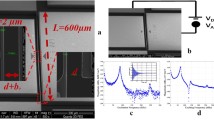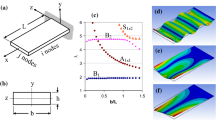Abstract
Mechanical coupling forms the basis for many exciting applications in tuning the frequencies of multi-degrees of freedom systems starting from coupling the motion of fire-flies to MEMS arrays. In this paper, the influence of the weak and strong coupling between two micromechanical cantilever beams is performed using the experimental and analytical studies. To do the study, the two types of coupled micromechanical beams are taken, namely, a weakly coupled beams and a strongly coupled beams. While the weakly coupled beams are coupled along their lengths through a coupling beam of constant length and width, two strongly coupled beams are coupled through beams of varying length and constant width with one end of its length fixed at fixed portion of cantilever beam. Here, we fabricated both types of coupled beams through microfabrication process. After measuring their in-phase and out-of-phase frequencies with varying coupling parameters, the influence of coupling parameters on these two modes is investigated. It is found that one of the modes consist of a transverse mode and another a kind of torsional mode which lead to out-of-phase mode. After finding this interesting observation, further analysis is done using the corresponding analytical models of transverse and torsional modes. Furthermore, the generalized analytical models are developed to capture the effects of coupling in weakly and strongly coupled beams as a function of coupling element dimensions.






Similar content being viewed by others
References
Abdelkefi A, Najar F, Nayfeh AH, Ben Ayed S (2011) An energy harvester using piezoelectric cantilever beams undergoing coupled bending-torsion vibrations. Smart Mater Struct 20:115007
Ashok A, Kumar PM, Pal P, Pandey AK (2018) An idea of oscillating alphabets through mechanical coupling. ISSS J Micro Smart Syst 7(2):145–150
Ashok A, Gangele A, Pal P, Pandey AK (2018) An analysis of stepped trapezoidal shaped microcantilever beams for MEMS based devices. J Micro Microeng 28:075009
Ashok A, Manoj Kumar P, Singh SS, Raju P, Pal P, Pandey AK (2018) Achieving wideband micromechanical system using coupled non-uniform beams array. Sens Actuat 273:12–18
Ashok A, Nighot RP, Devsoth L, Yadav M, Pal P, Pandey AK (2020) Experimental and theoretical analysis of drag forces in micromechanical beam arrays. Phys Rev Applied 13(3):034003
Buks E, Roukes ML (2002) Electrically tunable collective response in a coupled micromechanical array. J Microelectromech Syst 11(6):802–807
Gangele A, Akarapu A, Sharma CS, Pal P, Pandey AK (2019) Frequency analysis of hexagonal microbeam with 2D nanofiber mat. IOP Mater Res Express 6(8):085631 (1-10)
Hammad BK (2014) Natural frequencies and mode shapes of mechanically coupled microbeam resonators with an application to micromechanical filters. Shock Vibr. https://doi.org/10.1155/2014/939467 (Article ID 939467)
Kambali PN, Swain G, Pandey AK, Buks E, Gottlieb O (2015) Coupling and tuning of modal frequencies in direct current biased microelectromechanical systems arrays. Appl Phys Lett 107:063104
Kumar L, Jenni LV, Haluska M, Roman C, Hierold C (2018) Mechanical stress relaxation in adhesively clamped carbon nanotube resonators. AIP Adv 8:025118
Leissa, Arthur W (1969) Fundamental equations of classical plate theory, National Aeronautics and Space Administration, pp. 362
Li L (2015) In search of optimal mode localization in two coupled mechanical resonators. J Appl Phys 118:034902
Pandey AK (2013) Effect of coupled modes on pull-in voltage and frequency tuning of a NEMS device. J Micromech Microeng 23(8):085015
Rao SS (2003) Mechanical vibrations, pearson education India
Rao SS (2007) Vibration of continuous system. Wiley, Hoboken
Sahoo DK, Pandey AK (2018) Performance of non-uniform cantilever based piezoelectric energy harvester. ISSS J Micro Smart Syst 7(1):1–13
Sakawa Y, Luo ZH (1989) Modeling and control of coupled bending and torsional vibrations of flexible beams. IEEE Trans Auto Cont 34:970–977
Spletzer M, Raman A, Wu AQ, Xu X, Reifenberger R (2006) Ultrasensitive mass sensing using mode localization in coupled microcantilevers. Appl Phys Lett 88:254102-1- 3
Sriramdas R, Pratap R (2017) Scaling and performance analysis of MEMS piezoelectric energy harvesters. J Microelectromech Syst 26:679–690
Thiruvenkatanathan P, Yan J, Woodhouse J, Seshia AA (2009) Enhancing parametric sensitivity in electrically coupled MEMS resonators. J Microelectromech Syst 18(5):1077–1086. https://doi.org/10.1109/JMEMS.2009.2025999
Verbiest GJ, Xu D, Goldsche M, Khodkov T, Barzanjeh S, von den Driesch N, Buca D, Stampfer C (2016) Tunable mechanical coupling between driven microelectromechanical resonators. Appl Phys Lett 109:143507
Verbridge SS, Shapiro DF, Craighead HG, Parpia JM (2007) Macroscopic tuning of nanomechanics: substrate bending for reversible control of frequency and quality factor of nanostring resonators. Nano Lett 7:1728
Vijayan K, Friswell MI, Haddad Khodaparast H, Adhikari S (2015) Non-linear energy harvesting from coupled impacting beams. Int J Mech Sci 96–97:101–109
Wang DF, Chatani K, Ikehara T, Maeda R (2015) Enhancing amplitude changes by mode localization in trio cantilevers with mass perturbation. J Micromech Microeng 25:095017–1-8
Weinstein D, Bhave SA, Tada M, Mitarai S, Morita S (2007) Mechanical coupling of 2D resonator arrays for MEMS filter applications. In: Proc. Joint 21st Eur. Freq. Time Forum IEEE Int. Freq. Control Symp. pp 1362–1365 May/Jun
Zaitsev S, Pandey AK, Shtempluck O, Buks E (2011) Phys Rev E 84:046605-1-10
Zhang H, Huang J, Yuan W, Chang H (2016) A high-sensitivity micromechanical electrometer based on mode localization of two degree-of-freedom Weakly Coupled Resonators. J Microelectromech Syst 25(5):937–946. https://doi.org/10.1109/JMEMS.2016.2598780
Zhao C, Wang C, Cerica D, Baijot M, Xiao Q, Stoukatch S, Kraft M (2018) A mass sensor based on 3-DOF mode localized coupled resonator under atmospheric pressure. Sens Actuat 279(15):254–262
Acknowledgements
The research is supported in part by the Council of Scientific and Industrial Research (CSIR), India (22(0696)/15/EMR-II).
Author information
Authors and Affiliations
Corresponding author
Additional information
Publisher's Note
Springer Nature remains neutral with regard to jurisdictional claims in published maps and institutional affiliations.
Rights and permissions
About this article
Cite this article
Manoj Kumar, P., Ashok, A., Pal, P. et al. Frequency tuning of weakly and strongly coupled micromechanical beams. ISSS J Micro Smart Syst 9, 117–130 (2020). https://doi.org/10.1007/s41683-020-00058-x
Received:
Revised:
Accepted:
Published:
Issue Date:
DOI: https://doi.org/10.1007/s41683-020-00058-x




